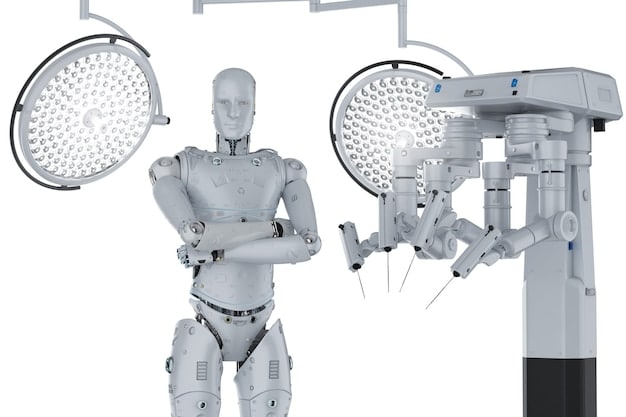FDA Regulations on AI Medical Devices in the US: Latest Updates

The latest FDA regulations on AI-powered medical devices in the US emphasize the need for transparency, safety, and effectiveness, focusing on premarket submissions, risk management, and continuous monitoring throughout the device lifecycle.
Navigating the rapidly evolving landscape of AI in healthcare requires a keen understanding of the regulatory frameworks in place. This article delves into what are the latest FDA regulations on AI-powered medical devices in the US, providing clarity and insights for innovators, healthcare professionals, and patients alike.
Understanding the FDA’s Role in Medical Device Regulation
The Food and Drug Administration (FDA) plays a pivotal role in ensuring the safety and effectiveness of medical devices in the United States. This oversight is crucial, especially when these devices incorporate artificial intelligence (AI), which introduces unique challenges and considerations.
The FDA’s regulatory approach aims to balance fostering innovation with protecting public health, a delicate act given the exponential growth of AI in medical applications.
Framework for Regulating Medical Devices
The FDA categorizes medical devices into three classes based on risk: Class I, Class II, and Class III. The level of regulatory control increases with each class, reflecting the potential risk to the patient.
- Class I devices pose the lowest risk and are subject to the least regulatory control.
- Class II devices require more stringent controls, often including special labeling requirements and performance standards.
- Class III devices are the highest-risk devices and require premarket approval (PMA) to ensure safety and effectiveness before they can be marketed.
AI-powered medical devices can fall into any of these classes, depending on their intended use and associated risks. The FDA’s approach to regulating these devices is evolving to keep pace with technological advancements.
The FDA categorizes AI-powered medical devices into different classes based on their potential risks and intended use. This classification determines the level of regulatory control required, ensuring that patient safety remains a top priority while allowing for continued innovation in the field.
Key Regulatory Considerations for AI-Powered Medical Devices
When it comes to AI-powered medical devices, there are several key regulatory considerations that manufacturers must address. These include data quality, algorithm transparency, and cybersecurity.
The FDA places a strong emphasis on ensuring that these devices are safe, effective, and reliable. Here’s a closer look at the considerations shaping the regulatory landscape:

Data Quality and Bias
AI algorithms are only as good as the data they are trained on. Therefore, the FDA emphasizes the importance of using high-quality, representative data sets to develop and validate AI-powered medical devices. Bias in the training data can lead to inaccurate or unfair results, which can have serious implications for patient care.
Manufacturers must demonstrate that their data sets are free from bias and that their algorithms perform consistently across different patient populations.
Algorithm Transparency and Explainability
The FDA also requires manufacturers to provide information about the algorithms used in their devices. While it may not be possible to fully explain how an AI algorithm arrives at a particular decision, manufacturers should provide as much transparency as possible about the algorithm’s inputs, outputs, and decision-making process.
This transparency is essential for healthcare professionals to understand how the device works and to make informed decisions about its use.
Cybersecurity
As with any connected medical device, cybersecurity is a major concern for AI-powered devices. The FDA requires manufacturers to implement robust cybersecurity measures to protect against unauthorized access, data breaches, and other cyber threats.
These measures should include regular security updates, vulnerability assessments, and incident response plans.
Data quality directly influences the reliability of AI-powered devices. Bias in algorithms poses significant risks to patient care. Transparency helps keep clinicians and patients informed about how the devices function.
Premarket Submissions and Approval Pathways
Manufacturers of AI-powered medical devices must navigate the FDA’s premarket submission and approval pathways to bring their products to market. Here is an overview of those pathways:
Understanding the different pathways available is critical for ensuring compliance and expediting the review process.
- 510(k) Clearance: This pathway is for devices that are substantially equivalent to a legally marketed predicate device.
- De Novo Classification: This pathway is for novel devices that are not substantially equivalent to a predicate device but pose a low to moderate risk.
- Premarket Approval (PMA): This pathway is for high-risk devices that require a more rigorous review to ensure safety and effectiveness.
The choice of pathway depends on the device’s risk classification and whether it is substantially equivalent to an existing device. For AI-powered medical devices, the FDA may require additional information to assess the device’s performance and safety.
Manufacturers need to ensure they meet all necessary requirements before bringing their AI-powered medical devices to market. Compliance ensures both safety and innovation through the FDA’s regulatory process.
The FDA’s Evolving Approach to AI in Healthcare
The FDA recognizes that AI is rapidly changing the landscape of healthcare and is committed to adapting its regulatory approach to keep pace with these changes. This involves developing new guidance documents, participating in collaborative initiatives, and engaging with stakeholders to understand the unique challenges and opportunities of AI-powered medical devices.
The FDA recognizes that static regulatory frameworks will not suffice for AI; continuous adaptation is essential.
Draft Guidance Documents
The FDA has released several draft guidance documents outlining its current thinking on regulating AI-powered medical devices. These documents cover topics such as data quality, algorithm transparency, and cybersecurity. They provide valuable insights for manufacturers seeking to develop and market these devices.
Collaborative Initiatives
The FDA is also participating in several collaborative initiatives to advance the development and use of AI in healthcare. These initiatives bring together experts from industry, academia, and government to address common challenges and develop best practices.
Engagement with Stakeholders
The FDA recognizes the importance of engaging with stakeholders to understand their perspectives on AI-powered medical devices. This includes holding public workshops, soliciting feedback on draft guidance documents, and meeting with manufacturers and other interested parties.
The FDA is dedicated to adapting its strategies through guidance, collaboration, and open dialogues. These strategies aim to promote continuous improvement and regulatory refinement for AI in healthcare.
Real-World Examples of FDA-Regulated AI Medical Devices
To better understand how the FDA’s regulations apply in practice, let’s look at some real-world examples of AI-powered medical devices that have been cleared or approved by the agency. This showcase provides potential developers with clear objectives as they navigate the regulatory pathways.

- AI-powered Diagnostic Imaging: Several AI algorithms have been cleared by the FDA to assist radiologists in detecting abnormalities in medical images such as X-rays, CT scans, and MRIs.
- AI-based Continuous Glucose Monitoring: Some continuous glucose monitoring (CGM) systems use AI algorithms to predict glucose levels and provide alerts to patients with diabetes.
- AI-driven Surgical Robots: AI is also being used in surgical robots to enhance precision and improve surgical outcomes.
These examples demonstrate the broad range of applications for AI in medical devices and highlight the importance of the FDA’s regulatory oversight.
These examples of FDA-regulated AI medical devices illustrate how safety, innovation, and effectiveness can coincide. They set the groundwork for future advancements and continuous regulatory improvements.
Future Trends in FDA Regulation of AI Medical Devices
As AI technology continues to evolve, the FDA’s regulatory approach will need to adapt accordingly. There are several trends that are likely to shape the future of FDA regulation of AI-powered medical devices.
The regulatory environment is constantly changing and requires flexibility along with forethought. This adaptability is critical in optimizing regulatory pathways to promote cutting-edge healthcare innovations.
Real-World Evidence
The FDA is increasingly interested in using real-world evidence (RWE) to evaluate the performance of medical devices. This involves collecting data from routine clinical practice to assess how devices perform in real-world settings.
Adaptive Learning Algorithms
Adaptive learning algorithms, which can improve their performance over time, pose unique challenges for regulators. The FDA is developing new approaches to evaluate and monitor these algorithms to ensure that they continue to perform safely and effectively.
Digital Health Technologies
The FDA is also working to streamline the regulation of digital health technologies, including AI-powered devices. This involves clarifying the regulatory requirements for these technologies and developing new tools and resources to help manufacturers comply with these requirements.
Looking forward, the FDA is anticipated to integrate RWE, adjust to adaptive learning algorithms, and modernize digital health regulations. These adjustments are vital to successfully regulate and assist the cutting-edge AI technologies in healthcare.
| Key Aspect | Brief Description |
|---|---|
| 🛡️ Data Quality | Ensuring high-quality and bias-free datasets for AI algorithm training. |
| 🔐 Cybersecurity | Implementing robust measures to protect AI devices from cyber threats. |
| 📑 Premarket Approval | Navigating pathways like 510(k), De Novo, and PMA for device approval. |
| 📈 Real-World Evidence | Using clinical practice data to evaluate device performance post-market. |
What are the Latest FDA Regulations on AI-Powered Medical Devices in the US?
▼
The FDA’s main goal is to ensure these devices are safe and effective for patients. This involves thorough evaluation and ongoing oversight to manage associated risks.
▼
The FDA classifies devices into Class I, II, and III based on risk. AI devices can fall into any class, affecting the required regulatory controls.
▼
The FDA focuses on data quality, algorithm transparency, and cybersecurity in premarket submissions to ensure device safety and reliability.
▼
High-quality data is essential because AI algorithms learn from this data. Biased or inaccurate data can compromise the device’s accuracy and safety.
▼
Future trends include utilizing real-world evidence (RWE), adapting to machine-learning algorithms, and simplifying rules for digital health innovations for efficient and safe technology.
Conclusion
The FDA’s regulatory framework for what are the latest FDA regulations on AI-powered medical devices in the US is designed to ensure patient safety while fostering innovation. By understanding the key regulatory considerations, premarket submission pathways, and emerging trends, manufacturers can successfully navigate this complex landscape and bring safe, effective AI-powered medical devices to market, ultimately improving healthcare outcomes for all.





